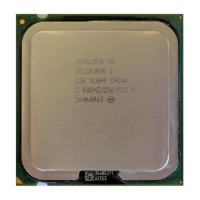Introduction
R
Thermal/Mechanical Design Guide 9
1 Introduction
1.1 Document Goals and Scope
1.1.1 Importance of Thermal Management
The objective of thermal management is to ensure that the temperatures of all components in a
system are maintained within their functional temperature range. Within this temperature range a
component is expected to meet its specified performance. Operation outside the functional
temperature range can degrade system performance, cause logic errors or cause component and/or
system damage. Temperatures exceeding the maximum operating limit of a component may result
in irreversible changes in the operating characteristics of this component.
In a system environment, the processor temperature is a function of both system and component
thermal characteristics. The system level thermal constraints consist of the local ambient air
temperature and airflow over the processor as well as the physical constraints at and above the
processor. The processor temperature depends in particular on the component power dissipation,
the processor package thermal characteristics, and the processor thermal solution.
All of these parameters are affected by the continued push of technology to increase processor
performance levels and packaging density (more transistors). As operating frequencies increase
and packaging size decreases, the power density increases while the thermal solution space and
airflow typically become more constrained or remains the same within the system. The result is an
increased importance on system design to ensure that thermal design requirements are met for
each component, including the processor, in the system.
1.1.2 Document Goals
Depending on the type of system and the chassis characteristics, new system and component
designs may be required to provide adequate cooling for the processor. The goal of this document
is to provide an understanding of these thermal characteristics and discuss guidelines for meeting
the thermal requirements imposed on single processor systems for the Intel
®
Pentium
®
4 processor
in the 775–Land LGA package.

